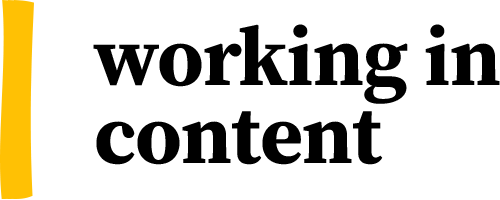In the eleventh video of our Perspectives series, we feature Christina Vasilevski, a Senior Content Designer at Scotiabank and member of Editors Canada. Christina shares her insights on managing ADHD in the content design profession. Her talk focuses on the challenges and strengths of having ADHD in this field and offers practical advice for coping and thriving. This presentation is a valuable resource for content designers looking to understand and navigate ADHD in their professional and personal lives.
Meet our speaker
Did you ever order books at school through Scholastic? If so, did you ever hear about an 11-year-old kid ordering a dictionary, a thesaurus, and a grammar guide from one of those flyers? Well, Christina was that kid.
She’s since made good on that obsession by crafting compelling, clear digital copy for banks, telecom companies and more for over a decade. In addition to working as a Senior Content Designer with Scotiabank, she’s a Certified Copy Editor from Editors Canada. (That grammar guide was a sign!) She lives near Toronto with her husband, cats, and a moderately ridiculous amount of tea.

About this talk
In her insightful presentation, Christina Vasilevski explores the intersection of ADHD and content design. She sheds light on the nature of ADHD, its various manifestations, and the specific challenges it poses in the field of content design. Christina not only discusses the hurdles but also highlights the unique strengths that ADHD can bring to the profession. She provides practical coping strategies and organizational methods to manage and excel with ADHD, making her talk a comprehensive guide for professionals navigating similar experiences.
Other videos in this series
Jeneba Wint shares innovative strategies for career development, using the concept of a 'Minimum Viable Product' (MVP) from product management.
Katrin Suetterlin explores the complexities of neurodiversity in the workplace, emphasizing the role of inclusive leadership and the need for a nuanced understanding of neurodivergent experiences.
Jen Dionisio shares her journey as a content strategist, her experiences in management and coaching, her personal growth during the pandemic, and offers insights and lessons to help others in their content strategy careers.
Lessons learned from Christina
Understanding ADHD in Content Design
Christina Vasilevski emphasizes understanding ADHD beyond the common misconceptions, highlighting its impact on focus and executive function. She stresses the importance of recognizing ADHD as a unique way of processing information, which can bring both challenges and advantages in the content design field. This insight is crucial for professionals in developing strategies to work effectively with or as individuals with ADHD.
Leveraging ADHD Traits in Creative Work
In her talk, Christina explores how traits commonly associated with ADHD, such as hyper-focus and creative thinking, can be beneficial in content design. She encourages embracing these qualities, illustrating how they can lead to innovative approaches and solutions in the workplace. Her emphasis is on seeing ADHD not just as a challenge but also as a potential asset in the creative process.
Practical Strategies for Managing ADHD
Christina provides practical advice on managing ADHD in a professional setting. She shares her personal techniques for staying organized and focused, such as using digital tools and structured approaches to tasks. These strategies are aimed at helping individuals with ADHD harness their strengths and mitigate challenges, thereby enhancing their effectiveness and productivity in content design roles.
About Perspectives Conf
This talk is part of Track #2 - Growing into a senior content role of the 2022 edition of our conference.
Perspectives Conf is the world’s first event specifically focused on the careers side of content. It’s been carefully curated to help people at all levels navigate the many facets of working in content – from being the first content person to hiring and growing a team.

Transcript of the talk
00:01 Hello everyone. And welcome to this discussion about succeeding in content design with ADHD. I hope you've been enjoying the conference so far in this presentation.
00:13 I'll be talking to you about what ADHD actually is. There's different types, how it manifests differently in different people and how it can be a strength rather than a liability in content design.
00:25 We'll also discuss coping mechanisms, ways to stay organized methods of maintaining focus in a demanding world and additional resources to learn more about how ADHD works.
00:37 So about me, I'm Christina Vasilevski and I've been working in the world of content development for over 10 years. Right now I'm a senior content designer with Scotiabank.
00:47 One of Canada's big five banks. I'm also a member of Editors, Canada, and became a certified copy editor through them in 2018.
00:56 Like many people, the pandemic threw me for a loop. I knew before it was before it started, but I was experiencing some of the common symptoms of ADHD, like procrastinating on work projects and losing focus during conversations.
01:10 But because of the pandemic, things came to a head and in 2020, I sought out a psychologist and was diagnosed with both ADHD and anxiety.
01:22 Before we get into a lot of detail about ADHD. I want to go over a few things first. I need stress that I am not a medical professional.
01:30 If you think you might have ADHD, but don't have an official diagnosis or are considering taking medication for it, please talk to a doctor.
01:39 Also, this presentation is only going to provide a basic summary of how ADHD works. ADHD can manifest in many ways.
01:47 So it's possible the experience as a solution side scribe, won't be the best fit. I'll be sharing some resources at the end of this presentation so you can learn more.
01:58 So what exactly is ADHD? ADHD short for attention deficit hyperactivity disorder is a neurodevelopmental condition where a person's ability to stay focused on task is impaired.
02:12 I really think of it though, as being disrupted or inconsistent, as opposed to impaired disability is also called executive function.
02:19 And we'll talk about that more in a minute. It can have genetic causes, but can also be acquired through things like injuries to the brain exposure, to harmful substances or even lead poisoning.
02:30 The sum's really scary and using the word hyperreactive doesn't make things any easier, but as Phil Boissiere in his books, Thriving with Adult ADHD states.
02:41 The name itself is misleading. Quote, people with ADHD don't really have a deficit in their attention in a way they have too much attention.
02:49 The struggle lies in their ability to regulate where their attention is focused and for how long most adults with ADHD are familiar with feeling either totally or locked in deep focus on a single task.
03:03 In other words, ADHD is not a moral defect. That's the quote from Jessica McCabe, the person who founded, How to ADHD and a recent podcast, where she discussed her experiences of having ADHD.
03:18 It's no secret. The typical image of someone with ADHD is a little boy who just can't sit still in class.
03:24 However, the focus on these superficial behaviors can be very demoralizing. It's easy to buy into the social narrative that there's something wrong with you.
03:34 A few minutes ago, I mentioned the term executive function. So let's get into that further and discuss how that's at the center of what ADHD is and how it manifests.
03:45 Executive function describes our ability to regulate our behavior and emotions. It's primarily governed by the prefrontal frontal cortex in the brain.
03:55 Remember earlier, when I talked about how ADHD can be acquired through things like head trauma and exposure to harmful substances, this is the part of the brain affected by that executive function is often broken down into seven following ways.
04:09 Number one, self-awareness the ability to monitor and modify your own behavior. Number two inhibition, otherwise known as self-restraint number three, non-verbal working memory.
04:22 This is the ability told information and recent images from the past, in your mind, number four, verbal working memory, self speech, or, internal speech, AKA your inner monologue.
04:35 Number five, emotional self-regulation the ability to manage and process your own feelings using the first four skills. Number six, self motivation.
04:46 How well you can motivate yourself to do things, even if there's no immediate external consequence and number seven planning and problem solving, which is pretty self-explanatory.
04:58 When you look at these seven things and view ADHD as a disorder of executive function it's easy to see how common symptoms map onto these categories.
05:08 ADHD presents in three ways, inattentive, hyperactive, or impulsive, or a combination of the two inattentive type ADHD usually involves symptoms like daydreaming, difficulty focusing on tasks or losing everyday items.
05:25 This is the type I was diagnosed with. I lose track of my phone all the time, even though I barely leave my home
05:33 Hyperactive or impulsive ADHD usually involves symptoms like being unable to sit still fidgeting or taking unnecessary risks. I have some of these symptoms too.
05:43 Actually, I get really fidgety sometimes and I have to be careful not to interrupt people. When I talk, if you compare these symptoms to the executive function skills we discussed earlier, you can easily see how the two map onto each other, how having problems with selfrestraint shows up as fidgeting
05:59 or having difficulty planning shows difficulty following instructions.
06:06 So let's take a quick look now at how gender plays into ADHD, presentation and diagnosis. Most of the sources I've consulted for this presentation state that boys or men are typically diagnosed with hyperactive ADHD and that girls and women are typically diagnosed inattentive ADHD.
06:25 I should note that these resources use words like girls and boys and men and women, without going into further detail as a result, I've used the same language here.
06:34 However, I do not know how much research takes trans nonbinary and other forms of gender identity into account. So when discussing physiological issues like hormones and menopause, I'll be using more precise language, a large part of why diagnosis appears to be.
06:49 So mis-gendered is because of socialization. Women and girls have been comparatively underdiagnosed because the symptoms they show tend to be less disruptive and more socially acceptable.
06:59 People of color are often underdiagnosed for similar socio-cultural reasons. ADHD can also be affected by hormones. It often develops in assigned female at birth people during major hormonal changes like puberty and menopause and symptoms can vary in severity throughout the menstrual cycle.
07:19 This is because estrogen and progesterone are linked the production of the neurotransmitters that are most closely linked to ADHD.
07:29 So now that I've given you a brief overview of how ADHD works, I want to talk about how it intersects with our line of work.
07:36 I genuinely believe that having ADHD can provide some advantages when working in content design. So first I want to tackle the idea of people with ADHD, not having a deficit of attention, but having a deficit of control over what they pay attention to people without ADHD may decide to tackle things in
07:58 order of priority or because of the consequences of not doing a certain thing, but for a lot of people with, with ADHD, what grabs their attention is what interests them.
08:09 I'm going to read out an explanation for this many people, including myself, have found very clarifying. It's a Reddit post though.
08:14 So it's not academic research.
08:17 It's a common misconception that ADHD simply means being hyper and, or being unable to focus when a more accurate way to describe it would be not as an attention deficit, but as an executive function deficit.
08:31 That's why so many parents with children with ADHD are skeptical of the diagnosis. They see that little Timmy has trouble sitting still and paying attention to homework and chores.
08:40 yet he can sit down in front of the video game for hours at a time. See, he must be slacking off.
08:44 He doesn't really have trouble focusing a true explain, like I'm five on how this actually affects people. Is I C N U interest challenge, novelty and urgency.
08:56 If something doesn't meet one of those four categories, someone with ADHD, just isn't going to be able to do it.
09:03 Let's use doing the dishes as an example. Is it interesting? Not even slightly challenging, not really novel, no urgency, not yet.
09:13 But once that person with ADHD actually needs clean dishes, then it gets done because now it meets one of those four criteria.
09:21 In that sense, putting things off to the very last second is essentially a coping mechanism mechanism for ADHD rather than a symptom of it itself.
09:31 Hyper-focus is another manifestation of how attention works people with ADHD. This is when we get focused on one particular topic we're attached to the exclusion of almost everything else.
09:41 I must be honest. Sometimes hyper-focus can be destructive. When I was in my final year of undergrad, I got so obsessed playing with playing World of Warcraft that I dropped some courses and almost didn't graduate on time.
09:54 This sounds like a joke, but it's not. I only made it because I took some online courses the previous summer and submitted my coursework at the very last minute.
10:02 It's really easy for me to see that now as being assigned that I had ADHD, However chances are you're listening to me because content design is something you care about.
10:13 So it's possible to turn it into a, into a source of hyper-focus to your benefit, Because you know, with content design, there's an awful lot to learn about.
10:24 I mentioned earlier that one of the other ways that ADHD manifests is losing track during conversations, or at least that's what it does for me.
10:32 This happens to me in meetings, but I also think the distractability can be very useful because it helps us see our products, the way our users do.
10:40 They don't know all the features the way we do. They don't understand why the technology we're using imposes certain limits on what they want to do.
10:48 Informing users of all these nuances is unnecessary and overwhelming. And if there's one thing that people with ADHD spent a lot of time coping with it's feelings of overwhelm.
10:57 So as content designers, we're the ones best situated to put ourselves in our user's shoes. We need to cut through all the vague wording and marketing fluff on their behalf by, by showing empathy with their sense of confusion.
11:14 Plain language is one of the best ways to do this. The goal of plain language is to develop copy that is easy to read, provides the right information to your audience and helps people avoid misunderstandings and errors.
11:26 I've used the phrase cognitive load on this slide. And I think it's key, both understanding the digital copy and ADHD, cognitive load refers to how much working memory we're using on a given task.
11:38 And if you remember, we already talked about how executive function and working memory is affected by ADHD. So in situations where someone is dealing with a lot of new information at once, we define ways to reduce their cognitive load.
11:51 Plain language that's focused on clarity of expression is an important method. Many of the principles of plain language are already central to digital content practice like using the active voice, addressing readers directly avoiding jargon and presenting essential information only.
12:09 Plus plain language is better for SEO enough said Plain language has other benefits too. In the words of
12:30 that don't plain language removes barriers between you and your readers. It sets your organization apart from the competition resulting in increased conversions and loyalty, she goes on further.
12:43 No one has ever complained that the text was too easy to understand.
12:51 So we've gone over some of the potential positives of having ADHD. It's all about reducing the level of distraction for your audience, but work itself can be plenty distracting.
13:01 Let's look at some ways we can keep track ourselves as we deal with competing priorities.
13:08 We already discussed how people with ADHD have problems with working memory, taking notes of what you're being asked to follow, taking notes of what you're doing and what instructions you're being asked to follow is a key method of overcoming that because having that information means you don't need
13:23 to rely on your working memory as much. It doesn't have to be formal note taking even the fact that many of us are still working remotely.
13:31 We've already got chat systems like Slack or Teams built in also your notes. Don't have to be word for word often.
13:38 You'll form some stronger memories. If you try to synthesize the information in your own wording. One tip that I find really handy is that when I'm in a meeting where someone's sharing a PowerPoint presentation or going through a bunch of mocks in Figma, I use my screen capture tool to take screenshots
13:53 of the relevant visual on my monitor. Then I can copy and paste the screenshot into one note and make additional comments from there.
14:01 Speaking of which one note is central to my particular workflow, I tried, I recommend keeping all of your notes in one or two central repositories.
14:11 I keep track of meeting notes in OneNote and keep track of all my projects in an Excel spreadsheet. If I'm given a URL for Figma or for Confluence, I'll copy and paste it into both places where I can cross reference later.
14:25 Speaking of OneNote and Excel, it's important to remember that many of the most common tools we use in our day-to-day work have additional features built into them.
14:34 Using these features can provide an important sense of safety or structure or scaffolding and improve your memory retention. For instance, when I get an email in Outlook that I consider important, I use the little red flag feature, flagged emails, go separately into an audit, go automatically into a
14:52 separate followup folder that I can then review at my own pace. Once I've reviewed the email and either done the required action or emailed the person necessary.
15:03 I then unflag, when I unflag a lot of items, it feels amazing. You can also do something similar in Slack, by bookmarking and saving specific slack, Slack messages, and then unbookmarking them once you've actioned them.
15:16 I also recommend using Outlook or another calendar to block off time to work on important projects ahead of time. This ensures I get things done on deadline and prevent others from inviting me to meetings when I'm busy.
15:30 Um, I talked a few minutes ago about how people with ADHD, are drawn to tasks that develop interest challenge, novelty and urgency waiting until you've run out of a dish.
15:39 Dishes, before you wash any is a maladaptive form of this, but you can engineer your works that you can use these four things to your advantage.
15:48 One thing I like to do in both my work and home life is to set myself timers. Pomodoro timers are a classic example of this, but outside of work, sometimes I just set a kitchen timer and see how much cleaning I can get done in a half hour or 45 minutes.
16:03 I incorporate urgency in a healthy way. You can get a lot more done faster than you think. Sometimes these forms of inducing focus are short-lived timers work for a week and then they don't.
16:15 So then I might switch to listening to some white noise. Changing up your methods is itself a valid method to maintain focus.
16:26 All of the methods I've discussed so far involve focusing on the self, but seeing how your work affects others is just as important.
16:34 So I find that another way to personally keep track. I keep track. Despite the problems I have with staying focused is to keep other people informed about the status of the projects I'm working on.
16:45 For example, I try to send a weekly email to my manager about what I've worked on over the past week.
16:51 It doesn't have to be huge. just a bullet list is fine.
16:54 The bonus is that once your end time rolls around and you have to do your performance review, you have a series of emails documenting in short bullet point form.
17:04 Everything you've done over the past year, which makes filling in your performance reviews super easy. And I like saving time.
17:12 Another thing you can do is seek confirmation about next steps and important action items, the action items at the end of meetings, I do this and then I'd take those that information and put it into my notes.
17:25 Following the rule of write everything down, it doesn't have to be a big production. It can be as simple as saying, Hey, John, if I understand correctly, you need me to do X, Y and Zed, and you need this done in two weeks.
17:37 Have I missed anything? And that's it finally, every so often, it's good to go through all of your current projects in flight and check with your stakeholders to make sure you're still on track.
17:48 This is an excellent thing to do before. Going on vacation to ensure you have a few loose ends as possible before you leave, I often do this over Slack so that people can respond in line of the same thread.
18:02 Some of these tips sound pretty self-explanatory, you've probably heard tons of people telling you to just write stuff down. Sometimes the really obvious stuff doesn't work.
18:12 So it's important to trust your instincts about what will or won't be right for you. And frankly, sometimes people find being told the obvious thing kind of condescending.
18:21 And I don't want to do that to you. So find your best solution for yourself. However, I do have one last piece of advice,
18:30 Be kind to yourself the way the world currently works is built for neuro-typical brains. And frankly, a lot of the advice in this presentation is geared towards smoothing your way in a neuro-typical world.
18:44 The effects of ADHD in terms of lost time and wasted money are even greater on us than they are on the nerve to be neuro-typical people around us.
18:52 So take care of yourself. Change happens over time. So extend yourself some grace.
19:02 So, uh, I'm almost done. I just want to show you some of the resources I used to prepare this presentation.
19:08 These books, websites, and podcasts are some of the most helpful things I've found throughout my ADHD journey. So I will try and share an, a handout with this info in Slack.
19:18 Once this, uh, video goes live, but I'd like to highlight a few sources in particular, first Thriving with adult ADHD by Philip Boissiere.
19:27 This is a book I'm still working through, but I have underlined so many passages. Second, the Productivity Alchemy podcast, one of the hosts for this podcast is Ursula Vernon, and she has ADHD herself.
19:40 The hosts often interview, many neurodivergent guests Ursula's opens about having ADHD was one of the major reasons why I sought out my own diagnosis.
19:50 And finally, the ADHD women's subreddit. This was another source of really relatable info for me. And I highly recommend joining this subreddit if you're an active Reddite, user yourself.
20:02 So that's it. Thank you so much for taking the time to help to listen. And I hope this presentation helped you.
20:10 I'll be available in the conference Slack. Once this talk goes live, and I would really love to hear from you.
20:16 I'll try that. I'll try and share that list of resources in the Slack. If you want to get in touch after the conference.
20:21 My Twitter handle is at cvasilevski, C V A S I L E V S K I. And my email address is christina@christinavasilevski.com.
20:36 I hope you have a great day. Bye. Thank you so much.
Want to know when the next video from Perspectives Conf is published on our website? Sign up for our weekly newsletter in the box below to get notified.

















